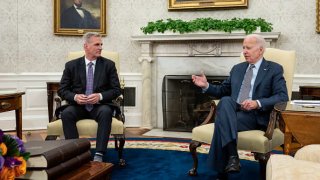
The House of Representatives voted Wednesday to raise the debt ceiling and avoid a default.
The agreement struck between President Joe Biden and House Speaker Kevin McCarthy that set up the vote comes after weeks of tense negotiations. It also comes with a condition that the student loan payment pause end after August 30.
"This bill does end the payment pause," Shalanda Young, director of the Office of Management and Budget, said in a press briefing. "But very close to the timeframe we were going to end it, as an administration, when it comes to repayment."
Around 45 million Americans are now trying to figure out when they'll need to make what could be their first payment on their student loans in three years. Here's what you can expect in the near term.
Get Southern California news, weather forecasts and entertainment stories to your inbox. Sign up for NBC LA newsletters.
Biden will not extend the payment pause again
As Young stated, the debt ceiling bill will lift the payment pause at the end of August. The Biden administration had previously planned to end the payment pause, at the latest, 60 days after June 30, which would be around August 30.
The bill adds a layer of certainty, though, by codifying that date and preventing Biden from issuing another extension as he has previously done. Secretary of Education Miguel Cardona acknowledged borrowers may be feeling anxious around payments starting up, but he says they should feel confident the administration is working to make it a smooth transition.
Money Report
"We're providing support for [borrowers], if they're struggling. We're rolling out a new income-driven repayment plan so their payments are more reasonable and manageable," he told Spectrum News.
In her press briefing, Young also acknowledged people could feel disappointed, but pointed out it could have been worse. She highlighted that some Republicans wanted to eliminate the possibility of student loan forgiveness as part of debt ceiling negotiations. That provision didn't make it into the final agreement.
"Even though [the] House Republicans' bill sought to do away with [debt forgiveness], we saved it in this bill," Young said. "There's nothing on that in this bill."
The bill Young mentioned, which aims to roll back loan forgiveness altogether, passed the House last week, and the Senate on Wednesday voted to advance the bill to debate. Biden has pledged to veto it if it makes it to his desk.
Loan forgiveness is still on the table, for now
Borrowers are still waiting to hear if the Supreme Court will approve Biden's plan to forgive $10,000 in student debt per borrower earning less than $125,000 a year and $20,000 for Pell Grant recipients. Around 16 million people were approved for forgiveness before the Biden administration was barred from processing applications.
"I know we have the legal authority [to forgive those loans]. I'm confident that we're gonna move forward with it," Cardona said.
It's not clear if, in the event the Supreme Court rules on Biden's plan debt forgiveness plan before June 30, the payment pause could be lifted sooner, as the original deadline was tied to that decision. The White House Office of Management and Budget did not immediately respond to a request for comment.
DON'T MISS: Want to be smarter and more successful with your money, work & life? Sign up for our new newsletter!
Get CNBC's free report, 11 Ways to Tell if We're in a Recession, where Kelly Evans reviews the top indicators that a recession is coming or has already begun.






